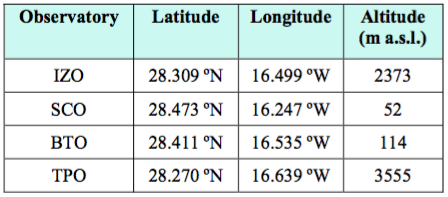The Izaña Atmospheric Research Center (IARC) manages four observatories in Tenerife: 1) Izaña Atmospheric Observatory (IZO); 2) Santa Cruz Observatory (SCO); 3) Botanic Observatory (BTO); and 4) Teide Peak Observatory (TPO).
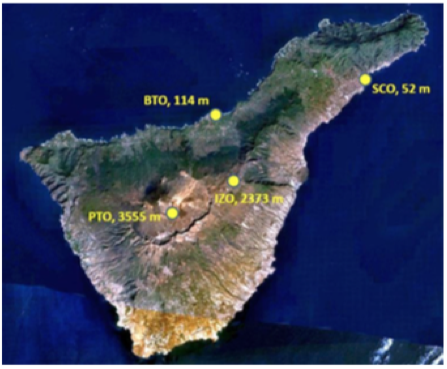
|
OBSERVATORIESIzaña Atmospheric ObservatorySanta Cruz ObservatoryBotanic ObservatoryTeide Peak ObservatoryCOMPUTING & COMMUNICATIONS |
The Izaña Atmospheric Observatory (IZO) is located on the island of Tenerife, Spain, roughly 300 km west of the African coast. The observatory is situated on a mountain plateau, 15 km north-east of the volcano Teide (3718 m a.s.l.). The local wind regime at the site is dominated by north-westerly winds. Clean air and clear sky conditions generally prevail throughout the year. IZO is normally above a temperature inversion layer, generally well established over the island, and below the descending branch of the Hadley cell.
back to menu
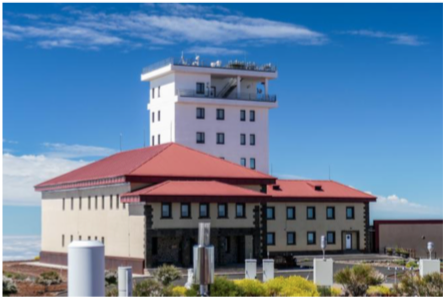
Image of Izaña Atmospheric Observatory
Consequently, it offers excellent conditions for trace gas and aerosol in situ measurements under “free troposphere” conditions, and for atmospheric observations by remote sensing techniques. The environmental conditions and pristine skies are optimal for calibration and validation activities of both ground-based and space-borne sensors. Due to its geographic location, it is particularly valuable for the investigation of dust transport from Africa to the North Atlantic, long-range transport of pollution from the Americas, and large-scale transport from the tropics to higher latitudes.
The Izaña Atmospheric Observatory facilities consist of three separate buildings: the main building, inaugurated in 1916; the aerosols lab, a small nearby building of the same period which was renamed “Joseph M. Prospero Aerosols Laboratory” on 8 April 2016; and the technical tower, completely rebuilt in early 2000, which hosts most of the instruments.
The main building is a two-storey building with a total area of 1420 m2, which hosts the following facilities: office space, dining room, kitchen, library, conference hall with audio-visual system, meeting room, engine rooms, a mechanical workshop, and an electronics workshop. In addition, there is residential accommodation available for visiting scientists (seven double en-suite rooms).
The technical tower is a seven-storey building with a total area of 900 m2. It includes 20 laboratories distributed among the different floors. All the laboratories are temperature- controlled.
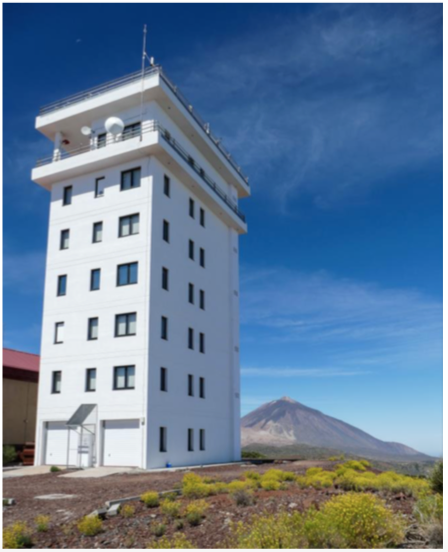
Image of IZO Instrument terrace and technical tower.
back to menu
The Santa Cruz de Tenerife Observatory (SCO) is located on the roof of the IARC headquarters at 52 m a.s.l. in the capital of the island (Santa Cruz de Tenerife), close by the city harbour.
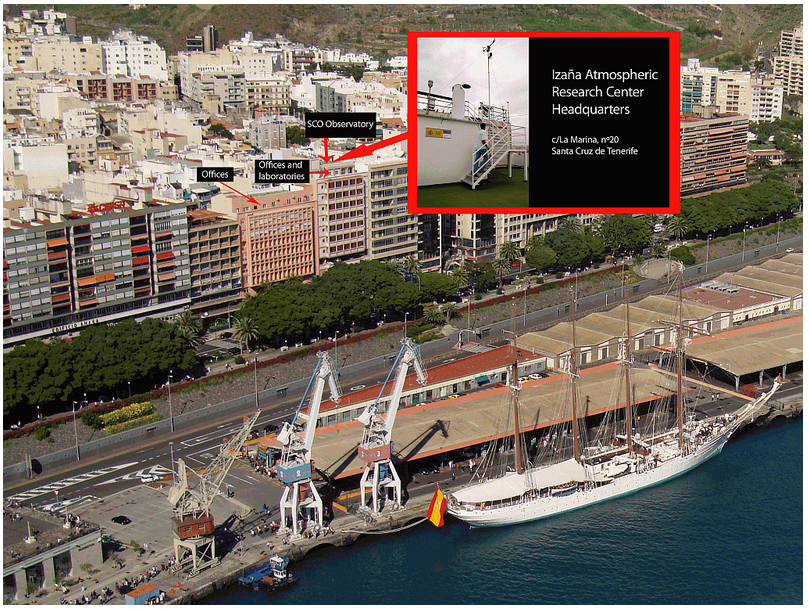
This observatory has two main objectives: 1) to provide information of background urban pollution for atmospheric research and interactions with long-range pollution transport driven by trade winds or Saharan dust outbreaks and 2) to perform complementary measurement programmes to those performed at IZO. The IARC headquarters include the following facilities:
- A laboratory for reactive gases (surface O3, NO-NO2, CO and SO2).
- A laboratory for micro pulse Lidar (MPL) and ceilometer VL-51.
- A laboratory to dry and weigh filters of high and low volume aerosol samplers.
- A laboratory for the preparation of ozonesondes
- A 25 m2 flat horizon-free terrace for radiation instruments and air intakes.
back to menu
The Botanic Observatory (BTO) is located 13 km north-east of IZO at 114 m a.s.l. in the Botanical Garden of Puerto de la Cruz. BTO is hosted by the Canary Institute of Agricultural Research (ICIA). The Botanic Observatory includes the following facilities:
- Ozone Sounding Monitoring Laboratory: equipped with a Digicora MW31 receiver with Vaisala METGRAPH data acquisition and processing software and a surface ozone analyser
- Launch container: equipped with a Helium supply system used for ozonesonde balloons filling.In addition to the ozonesonde measurements, there is a fully equipped automatic weather station (temperature, relative humidity, pressure, precipitation, wind speed and direction), a global irradiance pyranometer and a surface ozone analyser (also used for additional ECC electrochemical sondes ground checking). For details of the BTO measurement programme.
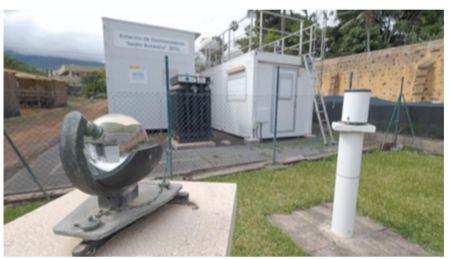
The Botanic Laboratory
Advanced preparation of the Science Pump Corporation (SPC) ECC ozone sensor (Model ECC-6A), together with digital Vaisala RS92 radiosonde and digital interface, is performed at the Ozonesonde Lab at SCO. Expendables such as radiosondes, interfaces, ozonesondes, ozone solution chemicals, syringes, needles, protection gloves, and triple distilled water are stored in this lab.
A Science Pump Corporation Model TSC-1 Ozonizer/Test Unit is used for ozonesonde preparation. This unit has been designed for conditioning ECC ozonesondes with ozone, and for checking the performance of the sondes prior to balloon release. The Ozonizer/Test Unit is installed inside a hood in which ambient air is passed through an active charcoal filter to destroy ozone and other pollutants (ozone- free air). The volumetric flow of the gas sampling pump of each ECC sonde is individually measured at the Ozonesonde Lab before flight. The pump flow rate of the sonde is measured with a bubble flow meter at the gas outlet of the sensing cell.
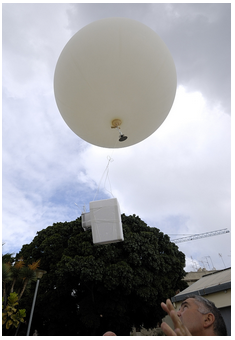
back to menu
The Teide Peak Observatory (TPO) is located at 3555 m a.s.l. at the Teide Cable Car terminal in the Teide National Park. TPO was established as a satellite station of IZO primarily for radiation and aerosol observations at very high altitude. TPO station, together with Jungfraujoch (3454 m a.s.l.) in Switzerland, are the highest permanent radiation observatories in Europe.
This measurement site provides radiation and aerosol information under extremely pristine conditions and in conjunction with measurements at SCO and IZO allows us to study the variation of global radiation, UV-B and aerosol optical depth from sea level to 3555 m a.s.l. In addition to radiation and aerosol measurements, there is a meteorological station and a water vapour isotopologues analyser.
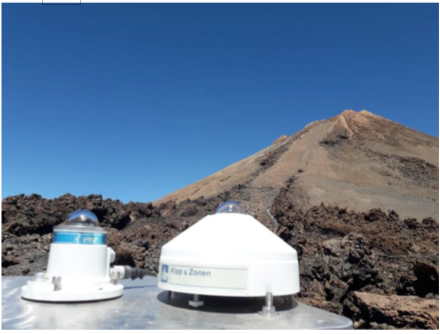
back to menu
Computing Facilities and Communications
The computing facilities and communications form an integral component of all measurement programmes and activities in the Izaña Atmospheric Research Center. In the IARC headquarters there is a temperature controlled room hosting server computers devoted to different automatic and continuous tasks (NAS, modelling, spectra inversion, etc.) for the research groups.
The IARC headquarters has internet access through a double optical fibre connection (20 Mb/s) to AEMET headquarters in Madrid, one of them acting as back-up. IZO is real time connected to IARC headquarters through a wifi-radio link (54 Mb/s) of 34 km. A EUMETCast (EUMETSAT’s Broadcast System for Environmental Data) reception station is available at SCO. It consists of a multi-service dissemination system based on standard Digital Video Broadcast (DVB) technology. Most of the satellite information is received via this system (see Section 13 for more details). An important communication advance in IZO was the establishment of a connection with the Iris Nova network, which has some of its nodes in the facilities of the Instituto de Astrofísica de Canarias (IAC) Teide Observatory.

